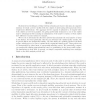Free Online Productivity Tools
i2Speak
i2Symbol
i2OCR
iTex2Img
iWeb2Print
iWeb2Shot
i2Type
iPdf2Split
iPdf2Merge
i2Bopomofo
i2Arabic
i2Style
i2Image
i2PDF
iLatex2Rtf
Sci2ools
QUESTA
2010
2010
Asymptotically optimal parallel resource assignment with interference
Motivated by scheduling in cellular wireless networks and resource allocation in computer systems, we study a service facility with two classes of users having heterogeneous service requirement distributions. The aggregate service capacity is assumed to be largest when both classes are served in parallel, but giving preferential treatment to one of the classes may be advantageous when aiming at minimization of the number of users, or when classes have different economic values, for example. We set out to determine the allocation policies that minimize the total number of users in the system. For some particular cases we can determine the optimal policy exactly, but in general this is not analytically feasible. We then study the optimal policies in the fluid regime, which prove to be close to optimal in the original stochastic model. These policies can be characterized by either linear or exponential switching curves. We numerically compare our results with existing approximations ba...
Cellular Wireless Networks | Different Economic Values | Heterogeneous Service Requirement | QUESTA 2010 |
| Added | 30 Jan 2011 |
| Updated | 30 Jan 2011 |
| Type | Journal |
| Year | 2010 |
| Where | QUESTA |
| Authors | Maaike Verloop, R. Núñez Queija |
Comments (0)

